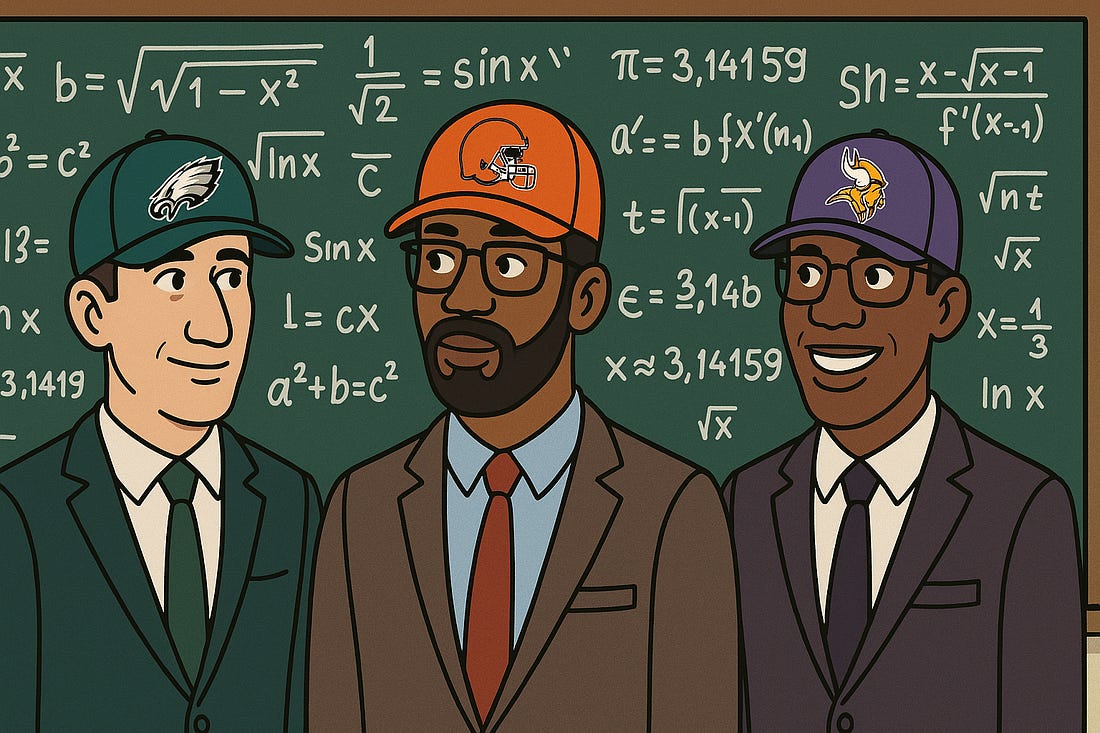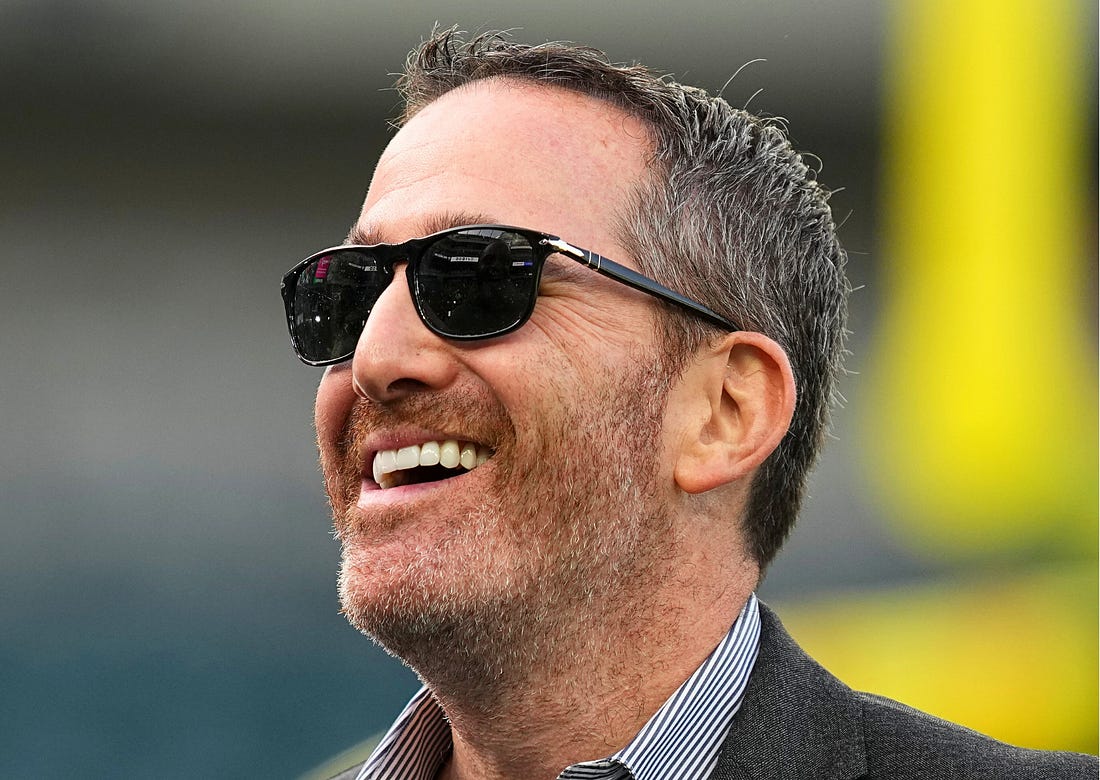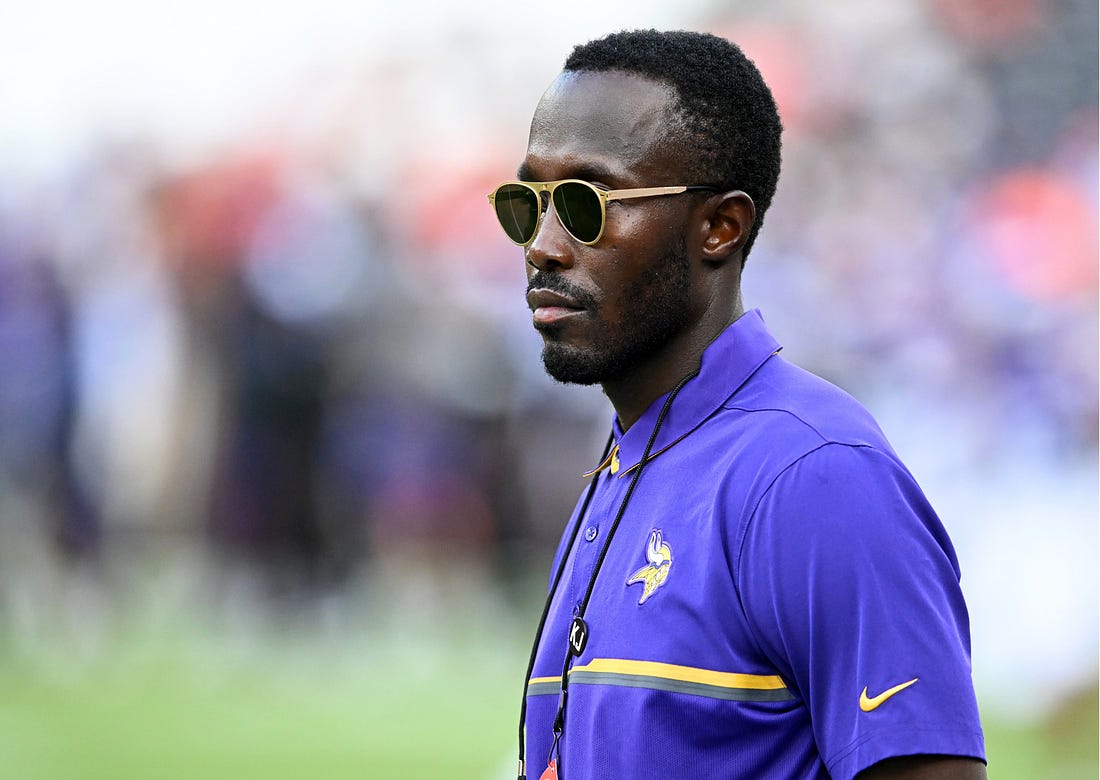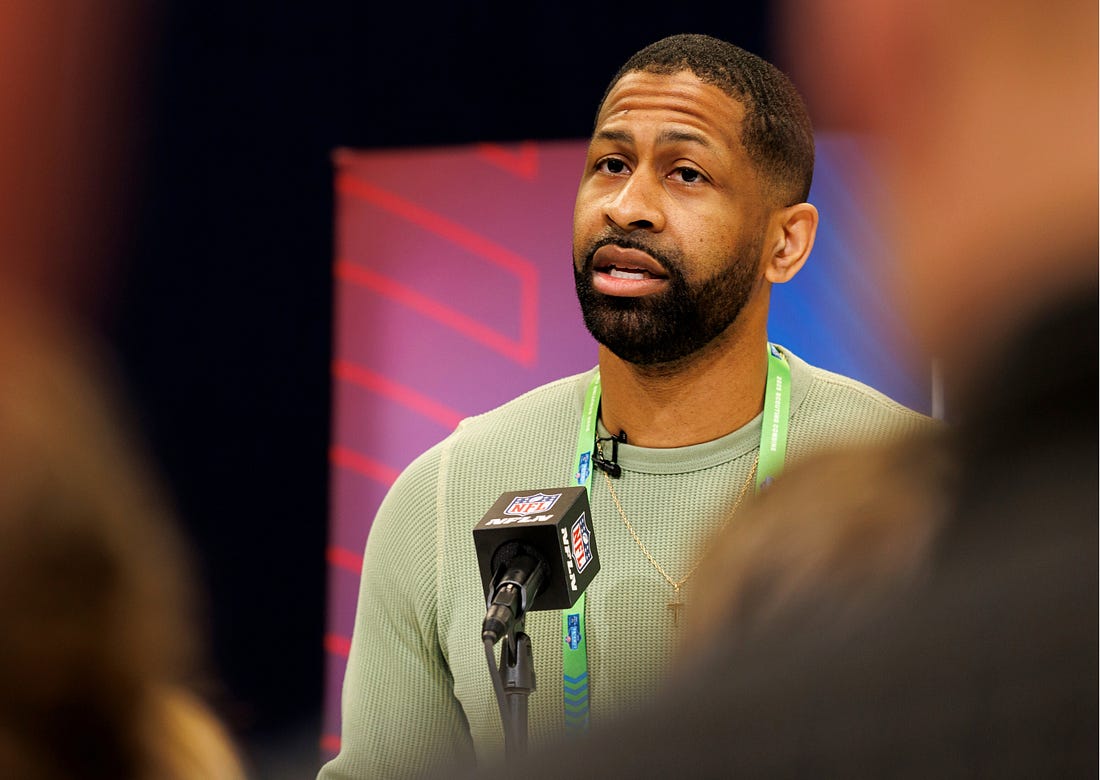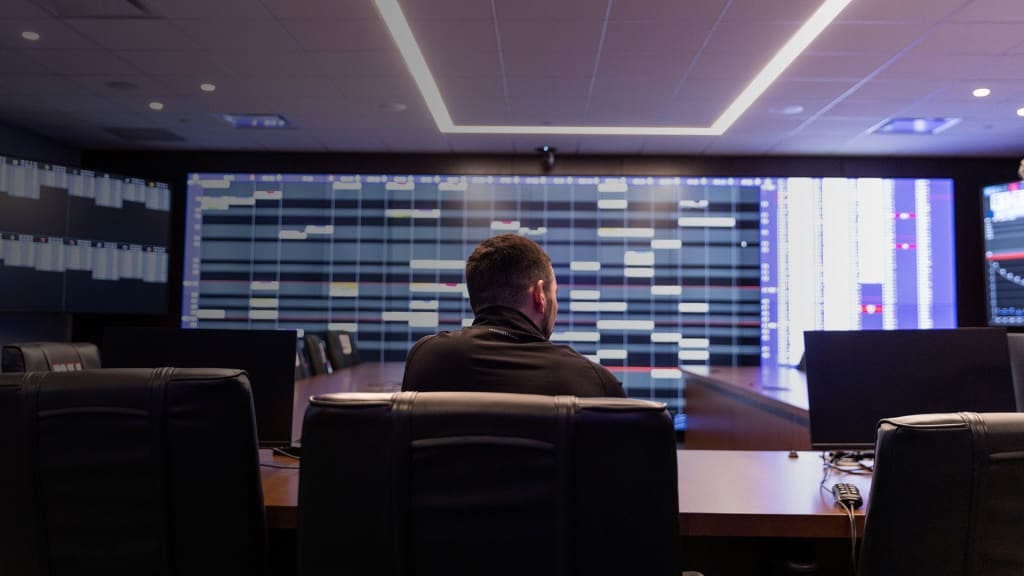How Ivy League Educated GMs Are Changing The NFL With Analytics
How Ivy League Educated GMs Are Changing The NFL With AnalyticsNFL teams used to trust scouts and gut instinct. Now, they’re hiring traders, data scientists, and Ivy League grads to run the war room. Here’s how analytics have changed the NFL forever.
NFL Draft rooms have changed a lot over the last few decades. Owners and head coaches were always involved, but the role of a general manager has evolved. A position once held by scouts with 40 years of film-watching experience, today’s general managers are likelier to have master’s and PhDs from the Ivy League elite. In Philadelphia, Howie Roseman mastered the salary cap to become the NFL’s youngest GM despite never playing a down of competitive football. In Cleveland, Andrew Berry turned down a job at Goldman Sachs, later using his master’s in computer science from Harvard to become the Browns head honcho. In Minnesota, Kwesi Adofo-Mensah has skillfully managed the Vikings roster to stay competitive after a decade trading derivatives at J.P. Morgan, Morgan Stanley, and Credit Suisse. The infiltration of analytics in sports is not a new concept. Brad Pitt turned the Oakland A’s revolutionary “Moneyball” era into a hit movie that grossed over $100 million worldwide. Daryl Morey led the NBA’s three-point revolution in Houston by forcing the Rockets to maximize expected points by diminishing the mid-range shot. The Boston Celtics even hired former chess prodigy Josh Waitzkin as a consultant, allowing him to attend coaches’ meetings, sit behind the bench during games, and have one-on-one sessions with players despite having no basketball experience. The NFL has historically lagged behind these sports due to the game’s complexity and smaller sample sizes. Just 16 games in the NFL versus 162 in MLB or 82 in the NBA made it harder to form firm conclusions. But that narrative has changed over the last decade. Today, every NFL team has an analytics department. These departments are typically staffed with PhDs from the country’s best universities, and they are involved in nearly every aspect of an organization, including free agency and draft preparation, injury prevention analysis, in-game consultation with coaches, and salary cap management. How did we get to a place where expected value and WAR are more popular terms in NFL buildings than the 40-yard dash and vertical jump? Well, it’s complicated. Back in the day, NFL teams had to work really hard to get information on potential prospects. Newspaper clippings, campus visits, and word-of-mouth recommendations served as the primary source of information. Then, scout grades, rudimentary stats, and basic football drills were added to a team’s repertoire to help support the process. The Dallas Cowboys were the first team to incorporate analytics when they hired a computer programmer named Salam Qureishi. The Indian immigrant had no prior knowledge of American football but leveraged his technological prowess to build a system that quantified prospects on five variables (e.g. quickness, competitiveness, strength), with a test run identifying future stars like Joe Namath and Dick Butkus. In the 1990s, Jimmy Johnson’s Cowboys also developed a “draft trade value chart” that served as an initial step toward quantifying pick value. However, most teams stuck to traditional scouting methods for decades until the league changed in the 2010s. Howie Roseman is a key figure in this transition. The Fordham-educated lawyer never played a snap of football at any level, but he knew from a young age that he wanted to run an NFL team. While at college, Roseman stored binders with player stats and even put up his own draft board in his apartment. From high school through college graduation, Roseman sent over 1,100 letters to all 32 NFL teams begging for a chance. In 2000, Roseman finally got his foot in the door when Eagles executive Joe Banner brought him in as a salary cap staff counsel intern. It was an unpaid position without a desk, and Roseman had to commute over an hour from New York to Philadelphia daily. However, Roseman accepted the job anyway and excelled, eventually moving up the organizational ranks to become the NFL’s youngest GM ten years later at 34. Huddle Up is a reader-supported publication. To receive new posts and support my work, consider becoming a free or paid subscriber. Early on, traditionalists labeled Roseman as a “salary cap guy.” In a league where GM roles are typically filled by former players (John Elway in Denver) or long-time scouts without advanced academic backgrounds (Ozzie Newsome in Baltimore), Roseman was an outlier. Then, the narrative got worse when a power struggle with Chip Kelly in 2015 led to Roseman losing personnel control — but we all know how that ended. After spending a little over a year on the business side, Roseman regained roster control in 2016 after Kelly was fired and has since become one of the NFL’s best GMs. Roseman constructed the roster that won Super Bowl LII in the 2017 season — the Eagles’ first championship since 1960 — and has been the architect of four Super Bowl teams in eight years, including another Super Bowl championship in 2025. Roseman wasn’t the first GM to incorporate analytics, but his success has opened the door for many more non-traditional NFL hires. Andrew Berry, for instance, has used his Computer Science degree to build one of the NFL’s most analytically advanced front offices in Cleveland, ending the team’s 27-year winless playoff drought in 2021. Minnesota’s Kwesi Adofo-Mensah is another name to watch because he has an even more unique background than Roseman and Berry. After spending a decade working as a derivatives trader on Wall Street, Adofo-Mensah has turned the Vikings into a perennial contender, despite entering his third straight season with a new starting QB. So what exactly do these analytically-minded GMs do that is so different from everyone else? That’s a complex question. We could talk about how they have built out analytics departments armed with proprietary technology to help coaches with in-game probabilities, or how they strategically use dead money on the salary cap as an interest-free loan to retool their rosters by paying out veteran players into the future. There is also the injury prevention component. The best NFL teams use technology to collect data on everything from how many steps a player takes during practice to their calories consumed and blood oxygen saturation to reduce injury exposure risk. Still, the best example of how analytics has changed the NFL comes through the draft. Every NFL team now spends draft weekend prioritizing positional value — the idea that a quarterback or edge rusher is more valuable than an inside linebacker. This is why you have seen running backs sliding down draft boards over the last decade. Metrics like Wins Above Replacement (WAR) and Approximate Value (AV) tell us that a top-tier quarterback is worth roughly 2.5 WAR, which is three times the average WAR of the next most impactful positions, like wide receiver (0.70 WAR), safety (0.60 WAR), cornerback (0.52 WAR) and way above running backs at 0.22 WAR. Huddle Up is a reader-supported publication. To receive new posts and support my work, consider becoming a free or paid subscriber. Rather than picking the best player available, teams filter the best player available through a positional value lens. But even that is really just scratching the surface. NFL teams use composite athletic scores like the Relative Athletic Score (RAS) when analyzing combine performance because it packages up a player’s height, weight, and all the combine drills into a standardized metric on a 0 to 10 scale. These scores are then put into proprietary models that leverage historical databases to compare a player’s athletic profile against thousands of other players, providing teams with a quantifiable score on how those metrics could/should translate into NFL success. One team might use this data as a hard cut-off, like removing an offensive tackle from its board because of his arm length, while other teams use the data to build preferred profiles based on past success, like the Seattle Seahawks in the 2010s becoming known for preferring tall cornerbacks with long arms and excellent vertical jumps. Data from the NFL combine is also just one piece of the puzzle. Since many combine drills don’t mimic real play, NFL teams add in-game tracking to their models. This data is gathered through GPS systems, and scouts love it because a player consistently hitting 21 mph on film is objectively more important than how he runs a 40-yard dash. The combine has become less important because services like Pro Football Focus (PFF) now provide NFL teams with very specific data. For example, rather than just saying a receiver had 1,000 yards in a season, PFF will look at what percentage of a team’s passing offense he accounted for (market share), his yards per route run, catch rate vs. expected, and how he performed compared to the quality of defense he faced. A player’s age, experience, and level of competition are also valuable, with all of this data being fed into regression or machine learning models that identify which metrics best predict NFL success by position. In fact, the models have gotten so good that teams now know a draft pick might have an 80% chance of becoming a quality starter. The best GMs don’t blindly trust this data; they combine it with traditional scouting methods to build a comprehensive profile that estimates the success of each draft pick. But that’s just the scouting process. The real fun begins when the draft starts. Every NFL team has its own trade value charts to determine what they should get or give up when moving around the NFL Draft. These trade charts are team-specific, as one team might value specific criteria more than another, but they all work similarly. Since a first-round pick is relatively cheap for his potential production, depending on the salary a veteran player commands at that position, models factor in that surplus value. The empirical performance curve looks at decades of data to determine how each draft slot translates to NFL performance. Think of this as a pick’s ROI in terms of cap dollars per win — the expected value curve flattens as the draft progresses because late-round draft picks are usually fringe players with a low chance of success. Huddle Up is a reader-supported publication. To receive new posts and support my work, consider becoming a free or paid subscriber. Expected Value (EV) modeling also enables teams to estimate what each pick should yield in terms of player value. For example, pick #10 might have an EV of one Pro Bowl player over a five-year span, whereas picks #20 + #50 together might have an EV of 1.3 Pro Bowl players. You obviously can’t draft 0.3 of a player, but you get the point. In this case, the EV data says two lower picks yield more value than one higher pick. This is precisely why we have seen a shift over the last decade, with many teams now willing to trade down during the draft. The consensus is that draft picks are lottery tickets, especially as you move further away from the top 10 to 15 picks. So, it’s often better to acquire as many lottery tickets as possible rather than only a few. Teams like the Patriots and Ravens have done this well over the last decade, with the one caveat being that it’s okay to move up if the player you are selecting is at a premium position. For example, a team’s model might project that picks 40 and 60 together have a 70% chance to net at least one quality starter, whereas pick 25 alone has only a 50% chance to net a quality starter. In that case, you could trade down, unless, of course, the player you are selecting at 25 plays a premium position that produces surplus value via WAR. Strategies change yearly depending on the team’s needs and the strength of the draft class. One year, teams might backfill a position through volume, selecting multiple players at the same position in the middle of the draft. Another year, that same team will trade up wisely, identifying massive outlier prospects at a premium position. Think of draft capital as currency. Teams are hiring Wall Street traders because navigating the draft now requires personnel who can adapt to changing conditions, allocating their portfolio of assets (draft picks) in a diversified and efficient manner to maximize returns (player performance). The NFL’s analytical revolution is not some big secret. Every NFL team now has at least one analytics employee on its staff, with some teams investing over $10 million in analytics each year. Furthermore, the vast majority of teams now have analytics folks wearing headsets on gameday with direct communication to the coaching staff, and the New York Giants even recently unveiled a new room exclusively used for NFL Draft prep, including 42 screens that can pull up any data point imaginable in seconds. However, some teams are better at incorporating analytics than others. The Eagles are the best example because they consistently target premium positions in early rounds and trade draft picks to acquire a mix of veteran players (AJ Brown) and rookies that analytics say should have been picked higher (DeVonta Smith, Jalen Carter). These three players alone greatly contributed to the Eagles’ most recent Super Bowl victory. But if we wanted to look outside the Eagles, other examples include the Minnesota Vikings, Cleveland Browns, Baltimore Ravens, Buffalo Bills, and San Francisco 49ers. These teams make bad decisions occasionally — the Deshaun Watson deal is an obvious mistake — but the more important part is that they also retool their rosters by letting veteran players go in exchange for compensatory picks. They focus on players with athletic traits proven to translate to the NFL and attack the draft through a hybrid approach, aggressively accumulating lottery tickets and only trading up for players at premium positions that the analytics say should have been drafted higher. Every NFL team will eventually incorporate these principles into its process. That doesn’t mean traditional scouts will be fired. But with the average NFL team now worth $6.5 billion and climbing, owners can’t afford to leave any stones unturned. If you enjoyed this breakdown, share it with your friends. Huddle Up is a reader-supported publication. To receive new posts and support my work, consider becoming a free or paid subscriber. You’re currently a free subscriber to Huddle Up. For the full experience, upgrade your subscription.
© 2025 |

